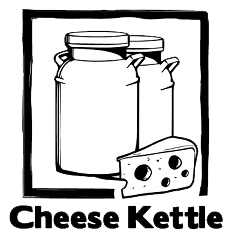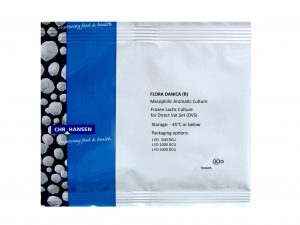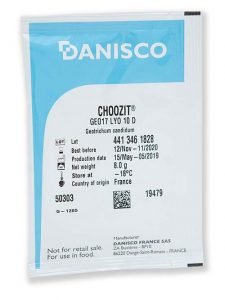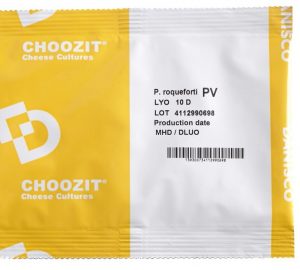Havarti is a semihard cheese that has a springy texture and a buttery aroma. It may taste from sweet to very sweet and a slightly acidic note. Stronger varieties of havarti can be sharper and nuttier. Created by Hanne Nielsen in the mid-1800s, this Danish delight is a perfect addition to any cheese platter.
Preparation Time: 11 hours and 40 minutes
Cook Time: 2 hours and 30 minutes
Yield: 1.2 kg Havarti cheese
Aging: 3 months
INGREDIENTS
1. 10 L full cream milk
2. 1/8 tsp Bioprox M265 Mesophilic Culture
3. ½ tsp Calcium Chloride diluted in ¼ cup water (nonchlorinated)
4. ½ tsp liquid rennet
5. cheese salt
6. cheese wax (optional)
Equipment
1. large pot
2. thermometer
3. curd knife and curd cutter
4. ladle or spoon for stirring
5. colander
6. cheese cloth
7. cheese hoop
8. cheese press
9. ripening container with a draining mat
Available at the Cheese Kettle Shop
Bioprox M265 is a mesophilic starter culture for making cheeses like Cheddar, Colby, Monterey Jack, Feta and Chevre.

Round Hoop for Havarti Cheese
Specifications: 230 mm diameter base x 110 mm height
INSTRUCTIONS
Reminder: Sanitize all your equipment before you make cheese.
1. Pour the milk into the pot and heat to 320 C. You can do this in two ways: by putting the pot directly on the stove in low heat or by doing a water bath.
2.Turn off the heat.
3. Sprinkle the mesophilic culture on the milk’s surface. Allow it to rehydrate for 5 minutes.
4. Stir the milk in an up and down motion for 1 minute.
5. Cover the pot and allow the milk to ripen for 45 minutes. Maintain a temperature of 210 C during this process.
6. Turn the heat back on and slowly raise the temperature back to 300 C.
7. Once the milk has reached the target temperature, add the rennet. Stir in an up and down motion for 1 minute.
8. Cover the pot again and allow the milk to set for 50 minutes.
9. Check the curds for a clean break. Plunge a clean finger or a knife into what seems like gelled milk and lift. The curds should be firm enough to break cleanly as the finger or knife is lifted and the whey should fill the gaps produced.
10. Cut the curds into ½-inch cubes with a curd cutter and a curd knife.
11. Maintain a temperature of 300 C. Stir the curds gently for 10 minutes.
12. Cover the pot and let the curds rest for 5 minutes.
13. Heat some water to 770 C while letting the curds rest.
14. Using a ladle, remove 1/3 of the whey from the pot. Make sure you measure how much this is.
15. Replace the whey that was with hot water (770 C). Make sure that the amount of water added is the same as the amount of the whey that was removed. Don’t pour the water into the curds at once. Do this slowly, making sure that the temperature does not exceed 380 C. If the temperature becomes too hot, you may pour in some cold water.
16. Add cheese salt to the pot and stir well for 30 minutes. Maintain the 380 C temperature during this stage.
17. Allow the curds to set again for 10 minutes. The curds should settle into a big mass after 10 minutes.
18. Line the colander with cheesecloth. Pour the curds in the colander and drain the whey. Break large curds to smaller chunks to drain out more whey.
19. Line your hoop with cheesecloth and put the curds in.
20. Fold the cheesecloth on top to cover the cheese.
21. Press the cheese at 5 kg of pressure for 20 minutes.
22. Turn the cheese over, redress it with cheesecloth and press at 13 kg of pressure for 8 hours.
23. Take the cheese out of the mold and place it in a ripening container. Cover the container.
24. Ripen the cheese at a temperature of 120 C at 90% humidity for 4 weeks.
25. Turn it daily during the first week of ripening.
26. For the next three weeks, turn it twice a week.
27. If you notice mold growth on the surface of the cheese, gently wipe it off with brine solution.
28. After 4 weeks, wax or vacuum pack the cheese and let it mature for 2 weeks to 3 months.
With Havarti’s creamy, smooth and tangy flavor, it complements a wide variety of food. You can pair it with mozzarella and put it on pizza, use it to make mac and cheese, or put it in a burger. It can also make a great addition to your cheese board.
Cheddar and Monterey Jack make wonderful substitutes for Havarti. Check out these recipes on how to make Cheddar and Monterey Jack.
Check out these Starter Cultures and Make Different Cheeses
Camembert and Brie Culture Pack
Flora Danica Mesophilic Culture Penicillium Candidum SAM 3 Geotrichum Candidum GEO 17
Blue Cheese Culture Pack
Penicillium Roquefort LM 57








